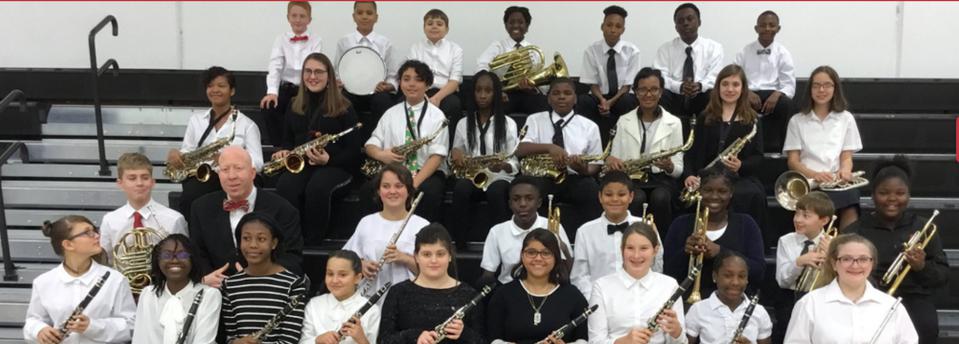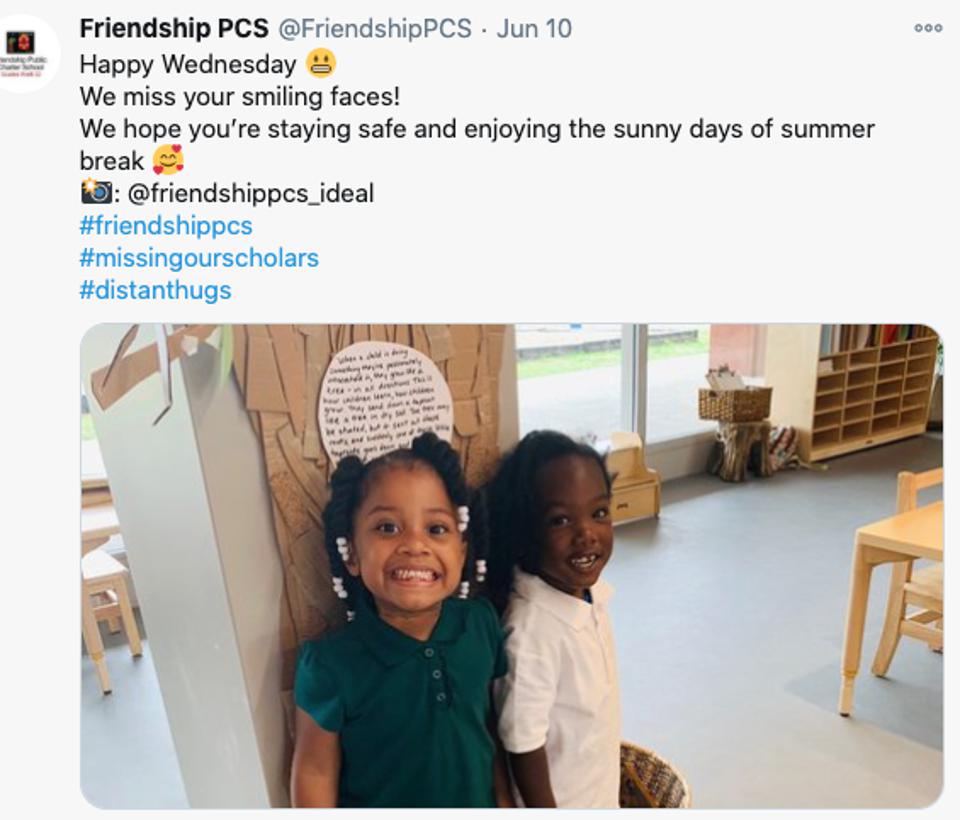
Great Education Should Have No Enemies – Charter Schools In The 2020 Election
The Latest Obstacles to Reopening Schools Forbes | October 31, 2020
By Jeanne Allen, Founder and CEO of CER

Students at Mevers School MEVERS SCHOOL OF EXCELLENCE
Myonia Hill’s successful journey through education in Washington, DC is owing to Friendship Collegiate Academy, part of the first black-led charter school network in the country. Located in what was once a dangerous neighborhood, Collegiate’s approval as a charter school, its development and its growth turned the area from one of crack houses and liquor stores to a safer and more desirable community. In August, Hill was on her way to Winston-Salem State University, a rarity for most kids in cities like DC.
“Parents believed that the school system was failing our children and they wanted something different,” Friendship founder Donald Hense once told reporter Roland Martin about his decision to create the school.
The students of Mevers School of Excellence of Goose Greek, SC benefit from access to music, languages, high expectations and safe buildings. The majority-minority student school outperforms its traditional public school counterparts in a community whose schools have historically been segregated by race and quality. The school belongs to the Charter Schools USA family of schools, a network of 95 schools serving 75,000 students across 5 states, with most in Florida. Founded in 1997 by Jon Hage, a policy expert who is an Army Veteran and Green Beret, its evolution from a small non-profit group to a large company that has launched dozens of innovations in teaching and learning across all of education is well documented. When graded as a district, CSUSA’s 61 Florida schools are “A-rated.”
Similarly 96% of Academica charter schools in Florida received an “A.” The network with over 200 schools serving 125,000 students across 9 states manages the work of charter schools like entertainer Pitbull’s Sports Leadership and Management Academy (SLAM) High School in Miami, which has been vital for many of its graduates. “It means so much to me because I worked so hard for this moment for so many years,” said graduate Amanda Milian, “and finally being able to be there with my family and with the people who mean the most to me, it’s been very fun, to say the least.”
The average math and reading proficiency in Buffalo’s traditional public schools is less than 30 percent. But the scores of Buffalo United Charter School surpasses that for most students, particularly its neediest. One of 96 schools serving 60,000 students across 9 states, the charter is part of the schools managed by National Heritage Academies, founded by J.C. Huizenga, a successful entrepreneur who thought he could apply successful business concepts to helping create great schools.
One of the things that ties these groups together is that they are what the enemies of charter schools want to call for-profit, but a better description is that they are by-profit. They use their tax status as a way to raise capital for what they are doing to make education better and they achieve that using a profit mechanism. In addition, they are accountable – they can be fired.
That’s the major reason charter schools came into existence nearly 30 years ago, to be free and accountable for student outcomes and to manage their own operations, budgets and curricula. The “non-religious, publicly-funded schools are privately run by various universities, local governments, or other organizations... Since charter schools are public, they must follow guidelines similar to traditional public schools such as the provision of a free public education, open enrollment, and implementation of state and federal assessments.”
Charters’ intellectual champion, Ted Kolderie, argued in 1990 that states could drive the improvement of public education first by opening enrollment and then by establishing choices in the form of viable, recognized, diverse alternatives. Almost overnight, the idea caught on. A Time Magazine 1994 headline proclaimed charter schools “a grassroots revolution.”
These two simple ideas—that teachers, citizens and parents working together could create better programs and instruction tailored to the needs of kids than large, amorphous, unaccountable bureaucracies, and that parents with diverse offerings would serve their children best—were transformative. Laws enacted with huge bi-partisan coalitions created the wildly popular charter schools which today have been attended by well over 15 million students.
That’s why recent commentary – just hours from the election – calling to question the worth of tax-paying companies that are managing charter schools is so curious. Writes Richard Barth, the CEO of the well-regarded KIPP, “Former Vice President Biden has said that he is against private charters. If what he means by ‘private charters,’ is a for-profit charter, then I – as the CEO of the largest network of [non-profit] public charter schools in the country – agree.”
People of color – and mostly Democrats – have been pleading with Joe Biden for months to embrace the innovative model. But he still said he would work to shut down charter schools. “…I am not a charter school fan because it takes away the options available and money for public schools.”
In 2019, at a Town Hall in Houston held by charters’ biggest adversary, Biden said, “I do not support any federal money, private money for for-profit charter schools, period.”
This paints a fictitious category of charter schools designed to unsettle and undermine public support for chartering. By calling them for-profit, it creates the illusion that these schools are bad for kids and just intended to make money. The reality requires an understanding of what non-profit and for-profit literally mean. Charter schools are non-profit by law. The only difference between KIPP and an Academica is that the latter pays taxes and the former does not.
By-profit management companies that manage public schools also have all the risk. Someone is on the line if bills don’t get paid. Unlike KIPP, they don’t raise money that they don’t have to return. They invest hundreds of millions of dollars in private capital in communities in developing schools, staff and new facilities, which create more jobs in the community. The by-profit model uses its access to capital markets (all the major banks lend to charters) which helps them grow and serve more students without having to solicit donations and be beholden to donor preferences and politics.
For example, when the Georgia courts in 2011 struck down the state’s charter law which was litigated by school boards and unions, by-profit companies like NHA were able to stick by their schools and not make a single budget cut. Some charters were not able to make it even after the legislature fixed the law.
So that brings us back to the pending election and the commentary.
The only benefit it seems from Barth’s statement and his larger piece on Biden’s positioning seems to be that perhaps with this on paper, a Biden Administration will not inadvertently sweep KIPP under the rug when his administration goes gunning for so called “private” charters. KIPP is currently the largest recipient of federal funds among all charter schools and has successfully lobbied in the past for ear-marked funds, just to their group.
And that’s not the most interesting part of all. Anyone from the early days of charters knows the story that KIPP was funded by investors who made substantial profits at Edison Schools, the first charter network created in the nation, founded by Chris Whittle, formerly editor of Esquire Magazine. Friendship Public Charter Schools, a non-profit, was started in partnership with Edison Schools, which capitalized the education and operational components with $40 million to launch the school.Edison was Friendship’s sole investor and its partner for about ten years until Friendship became its own non-profit manager. Whittle remains on the Friendship Board to this day. Hense, the tall, imposing Washington, DC icon whose entry into social service was as a prominent voice in the civil rights movement, sees no distinctions between who can or should manage schools, other than they should be qualified and accountable. Most advocates do not see any distinction.
Nor should Barth, who was an important leader at Edison Schools for almost a decade where he learned his trade and was recruited to run KIPP.

Friendship Public Charter School Students (Twitter) @FRIENDSHIPPCSLaws created with Edison’s support paved the way for KIPP and others. When they do well, it’s not because of their tax status, and not just because they have great programs, but because parents make a choice to attend. In 2007, when Buffalo’s KIPP Sankofa Charter School was “shut down for low test scores, high teacher turnover” and more, parents were all too happy to go elsewhere.
Barth is right when he says, “Parents are relentlessly dedicated to making sure their children receive what every child deserves: a high-quality public education. This fact is often ignored when false terms like ‘private charters’ are thrown around, or when the public debate becomes one that pits public charter schools against traditional public schools. It’s time that we put this tired debate to bed.”
Yes, let’s put that tired debate to bed – entirely. The whole point of charter schools is to create diversity and options. Intramural fights on different kinds of charter schools confuse and weaken political support. They all work – by-profit, non-profit, schools in networks and those on their own.
Parents are not interested in whether some idyllic vision of public education is met. They, not governments, should decide what’s best for their children. Parents don’t ask if their charter is managed by tax-paying companies any more than they ask how much technology costs in a school. The only thing they want to know is, “will the school work for my child?”
And so should we.Follow Jeanne on Twitter or LinkedIn or some of her other work here.
Founded in 1993, the Center for Education Reform aims to expand educational opportunities that lead to improved economic outcomes for all Americans — particularly our youth — ensuring that conditions are ripe for innovation, freedom and flexibility throughout U.S. education.

